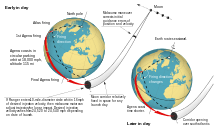Parking orbit
A parking orbit is a temporary orbit used during the launch of a satellite or other space probe. A launch vehicle boosts into the parking orbit, then coasts for a while, then fires again to enter the final desired trajectory. The alternative to a parking orbit is direct injection, where the rocket fires continuously (except during staging) until its fuel is exhausted, ending with the payload on the final trajectory.
Reasons for use
There are several reasons why a parking orbit may be used.
Geostationary spacecraft
Geostationary spacecraft require an orbit in the plane of the equator. Getting there requires a geostationary transfer orbit with an apogee directly above the equator. Unless the launch site itself is quite close to the equator, it requires an impractically large amount of fuel to launch a spacecraft directly into such an orbit. Instead, the craft is placed with an upper stage in an inclined parking orbit. When the craft crosses the equator, the upper stage is fired to raise the spacecraft's apogee to geostationary altitude (and often reduce the inclination of the transfer orbit, as well). Finally, a circularization burn is required to raise the perigee to the same altitude and remove any remaining inclination.[1]
Translunar or interplanetary spacecraft

In order to reach the Moon or a planet at a desired time, the spacecraft must be launched within a limited range of times known as the launch window. Using a preliminary parking orbit before final injection can widen this window from seconds or minutes, to several hours.[2][3] For the Apollo program's manned lunar missions, a parking orbit allowed time for spacecraft checkout while still close to home, before committing to the lunar trip.[3]
Design challenges
Use of a parking orbit requires a rocket upper stage to perform the injection burn while under zero g conditions. Often, the same upper stage which performs the parking orbit injection is used for the final injection burn, which requires use of a restartable liquid-propellant rocket engine. During the parking orbit coast, the propellants will drift away from the bottom of the tank and the pump inlets.[4] This must be dealt with through the use of tank diaphragms, or ullage rockets to settle the propellant back to the bottom of the tank. A reaction control system is needed to orient the stage properly for the final burn, and perhaps to establish a suitable thermal orientation during coast. Cryogenic propellants must be stored in well-insulated tanks, to prevent excessive boiloff during coast. Battery life and other consumables must be sufficient for the duration of the parking coast and final injection.
The Centaur and Agena families of upper stages were designed for such restarts and have often been used in this manner. The last Agena flew in 1987, but Centaur is still in production. The Briz-M stage often performs the same role for Russian rockets.
Examples
- The Apollo program used parking orbits, for all the reasons mentioned above except those that pertain to geostationary orbits.[5][6]
- When the Space Shuttle orbiter launched interplanetary probes such as Galileo, it used a parking orbit to deliver the probe to the right injection spot.
- The Ariane 5 does not use parking orbits. This simplifies the launcher since multiple restart is not needed, and the penalty is small for their typical GTO mission, as their launch site is close to the equator. An upgrade to the second stage (ESC-B) will have multiple restart capability, so future missions may use parking orbits.
- In a literal example of a parking orbit, the Automated Transfer Vehicle (ATV) could park for several months in orbit while waiting to rendezvous with the International Space Station. For safety reasons, the ATV could not approach the station while a Space Shuttle was docked or when a Soyuz or Progress was maneuvering to dock or depart.[7]
References
- Charles D. Brown (1998). Spacecraft Mission Design. AIAA. p. 83. ISBN 978-1-60086-115-4.
- Hall, R. Cargill (1977). LUNAR IMPACT - A History of Project Ranger. NASA History Series (Technical report). National Aeronautics and Space Administration. NASA SP-4210. Retrieved 2011-11-11.
- "Apollo Expeditions to the Moon". Chapter 3.4
- Krivetsky, A.; Bauer, W.H.; Loucks, H.L.; Padlog, J. & Robinson, J.V. (1962). Research on Zero-Gravity Expulsion Techniques (Technical report). Defense Technical Information Center.
- "Apollo lunar landing launch window: The controlling factors and constraints". NASA.
- "Apollo Flight Journal - Apollo 8, Day 1: Earth Orbit and Translunar Injection". NASA. Archived from the original on 2008-02-18.
- Stephen Clark. "Maiden launch of Europe's resupply ship gets new date". Spaceflight Now.